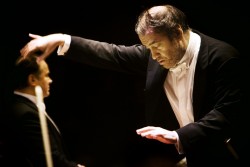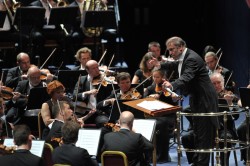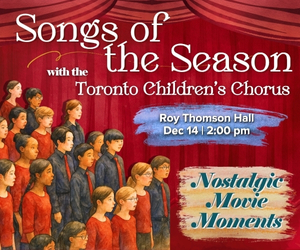Please click on photos for larger images.
In a historic concert at Roy Thomson Hall on October 6, Valery Gergiev led his Mariinsky Orchestra in a performance of Igor Stravinsky’s first three ballet scores. It is unlikely these three masterpieces of early 20th century music had ever been heard before in Toronto on the same program. According to the Carnegie Hall notes for a similar concert in New York several days later, Stravinsky himself conducted all three there in 1940 but used a suite version of The Firebird rather than the complete work that Gergiev programmed. By performing all three scores as they were first heard in 1910 (The Firebird), 1911 (Petrushka) and 1913 (The Rite of Spring) and in chronological order, Gergiev gave us the rare gift of the rakish composer’s progress from the height of romanticism to the birth of modernism.
Gergiev conducted without a baton but each of the fingers on his right hand, seemingly independent, directed the tempo and entrances, while his fluttering left hand occasionally rose to sweep his thinning hair back into place. The result was faultless, precise tuttis contrasted with transparency when appropriate, whether in woodwind interplay or solo strings. (In a New York Times Magazine profile from 2009, the principal clarinetist of the London Symphony Orchestra [Gergiev’s other musical child], revealed that it is the conductor’s expressive face, from the eyes to the mouth, that is the real source of his power).
The Firebird is a rich, colouristic playground of narrative that demands impeccable playing from every corner of the orchestra. From the early solo viola to the violin that announces the first trumpet solo, followed by the muted French horn’s entrance and the full horn section’s dialogue with the strings, to the oboe-clarinet-bassoon tune that leads into the strings’ mournful lament, the first half of the piece was a shining example of the conductor’s controlled reading of the score.
And so it continued, with the strings’ extraordinary precision from tremulousness to sudden stops, abrupt mood swings and consistent ensemble runs, in the face of the brass’ yattering exclamations and the soulful bassoon and beautiful final French horn solo, the string playing was never overblown or sentimental. Gergiev built the climax slowly; it was steady and heady until the tempo picked up and the brass triumphed leading to an immediate standing ovation.
After the first of two intermissions, Petrushka began with an impetuous rush before moving into the bucolic hemisphere of the country fair and the iconic dance-like flute solo that seemed to announce Stravinsky’s move from the 19th to the 20th century even as the cornucopia of folk rhythms and melodies confirmed it. A bonus of the 1911 version of the piece was the extensive use of the piano, both solo and in dialogue with the flute in particular. Apart from a brief trumpet solo that lacked the control that was so evident throughout this momentous concert -- which began at 2:15pm and finished at 5:05 -- the orchestra shone in the composer’s generous solo writing.
And as the snare drum motif led into a sumptuous conflation of tune and tutti followed by a de facto oboe and string quintet that moved into unbridled lyricism, Gergiev made sure to emphasize the bass notes in advance of the pure joy that ends in the proverbial whimper, always allowing the interior voices to be heard.
The Rite of Spring, arguably the most rhythmic orchestral music since Beethoven’s Seventh Symphony, followed the second intermission. Here the wonderful transparency of the orchestra brought out the cacaphony of the score, the sinuous viola solo (from a violist who, charmingly, couldn’t stop smiling whenever he soloed) and the languor transformed into rancour. Two exquisite moments of silence held by Gergiev’s outstretched right hand caught an audience so attentive that not one cough was heard. The clarity of the whole orchestra was remarkable as Gergiev made the pagans dance.
Toronto was fortunate to be one of only four cities (Chicago, New York and Washington were the others) to hear the Stravinsky program on the orchestra’s two-week tour of North America. During the tour, Gergiev also conducted two operas at the Met, Shostakovitch’s The Nose and Tchaikovsky’s Eugene Onegin. After a concert with the Mariinsky Orchestra in Montreal on October 4, Gergiev conducted a matinee of Onegin in New York on October 5, before the concert at Roy Thomson Hall the following afternoon. Whew.




